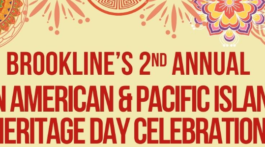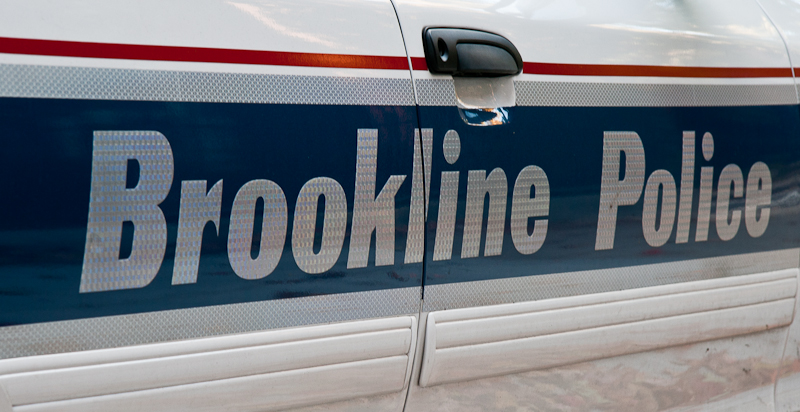Being a police chief in 2015 is not easy; being one who is as universally respected and liked among his officers, fellow town employees and residents, not to mention business, civic and religious leaders as Chief Daniel O’Leary—well, that’s rare indeed.
Chief O’Leary has been serving the Brookline PD for 37 years, the last 20 years as Department Chief. Brookline can be a complex community to serve. It is both urban and suburban with six major commercial areas. Brookline is a major entryway into Boston, which surrounds it on three sides, with heavy commuter auto, MBTA, bike and pedestrian traffic. It’s also home to some of the wealthiest neighborhoods in the country while more than 13% of its residents live at or below the poverty line. Brookline’s population is intensely diverse, as are the commuters who shop and enjoy life within its borders.
From the time Chief “Danny” O’Leary took the reigns two decades ago, improving community relations has been his calling card. Recently I sat down with the Chief and asked him questions about the police department’s work in community relations and how they tackle the complex task of addressing unconscious bias within the Force.
Publisher: Chief, before we talk about community relations and unconscious bias, overall, what are some of the unique challenges Brookline PD faces?
Chief: Brookline is surrounded on 3 sides by Boston so the profile of its drivers is not the same as profile of residents. This makes enforcing vehicular traffic challenging. To compare the race and sex of persons that a Police Department interacts with against the community’s census data is not an accurate way to determine if a Police Department is doing their work in a just manner. The census only accounts for people who live here and consider Brookline their primary residence. It does not take into account people who work, visit, go to school, commute through etc, which is more difficult to assess, but gives us a much more accurate picture. One way we tried to get an accurate picture was to volunteer for a pilot program with Northeastern University in 2008. They conducted a study of our auto accidents with the goal of getting an accurate account of persons’ race and sex based on who was operating the vehicles involved. We did not have enough accidents to give them a valid count. However, one of the things they did as part of this effort was to do a “windshield survey” where they placed graduate students at different locations and times around Brookline. These students took counts of who they believed were driving through Brookline and provided those statistics to us. Since that time we have used these statistics as a baseline for our traffic enforcement efforts.
—Chief O’Leary
Publisher: Chief, tell me some of the latest programs your department has instituted to further improve community relations?
Chief: Given all that is going on in the country dealing with Police and the Communities they serve, a good, solid, two-way community relation is a must. Recently, we instituted a Park and Walk program spearheaded by Deputy Superintendent Andrew Lipson. The major focus of this initiative is to have our officers spend time out of their vehicles and walk a certain section of their route. The officers are encouraged to meet the people who live and work in their areas. The officers can have a healthy two-way talk with them and listen to any concerns they may have. We are also working on different ways to get more information on what we do out to the public so they can see the good work our officers do day in and day out.
Chief’s Early Takeaway from Selectman’s Police and Community Relations Report
Publisher: In 1987, then-Selectmen Marty Rosenthal and Jeffrey Allen authored a Police and Community Relations report for the Board. Chief, how did your department work to institute some of the recommendations listed in the report?
Chief: Shortly after I became Chief, I reviewed that report with an eye to seeing how the Department had done with implementing the recommendations. I found that the Department had implemented most of them but not the one calling for the release of statistics on the race and sex of those we stop and identify, arrest, and cite for traffic violations. Starting in 1997 we began releasing these statistics publicly twice a year (July and January.) We also included people who file complaints about Police and of the Officers complained against. We have been releasing these consistently since 1997 and the most recent reports are posted on our website. We were definitely the first Department in the State and perhaps the Country to do that. This was done in an effort to be transparent and to let people know whom we interact with. These statistics have remained consistent over the years that I feel have made a positive impact on the relationship we have with our community. Marty was a strong advocate for publicly releasing these statistics.
Brookline PD and Unconscious Bias
Publisher: I’ve heard you talk a lot about unconscious bias, how we all have it, and how your department has worked hard to deal with this issue. Your department has been recognized nationally and internationally for its efforts. Can you talk about some of your department’s work in the area of unconscious bias?
Chief: Our officers are trained on unconscious bias so they can recognize it in themselves. Furthermore, our Supervisors have been trained on what to look for in doing a review of certain categories of statistics that will help identify when officers are operating outside of the norm. Part of the supervisor training is to help them understand unconscious bias and how to have a conversation on this topic with their assigned officers.
We have developed certain scenarios that officers encounter on the street and how we want our officers to act. Lieutenant Phil Harrington and several of our officers were trained in recognizing unconscious bias. They designed scenarios the state used for their statewide training efforts. The State has also used videos Lt. Harrington participated in as part of their training.
The International Association of Chiefs of Police (which number over 18k law enforcement agencies worldwide) selected Brookline PD as one of the recipients of their Civil Rights Award for the year 1997. This recognition was based on our continued efforts in combating racial profiling.
Publisher: How does analyzing metrics help your enforcement efforts?
Chief: Once a supervisor looks at the stats, he/she will talk to the officers if things don’t line up. We have found that a lot of times officers do not realize what their stats are and by bringing the stats to their attention, they can change their enforcement habits.
On one we noticed too high a percentage of minorities were being ticketed for moving violations. We realized too many tickets were being written early in shifts. The Force addressed the situation by ticketing more during rush hours to make the demographic of people receiving tickets more reflective of the actual stats. We used a more balanced approach and did enforcement both at the beginning and end of the shift so as to reduce the speed used by drivers during both commuting periods.
On a side note, many people may not realize that little more that 70% of moving violations are warnings and the rest are court complaints or arrests.
Violent Crime is Down in Brookline, But 2015 Shows Slight Uptick in Larceny Cases
Publisher: Anything you would like to add regarding your enforcement of crime in the community?
Chief: Brookline Police does a good job with crime. We have experienced a little more that 60% reduction in Part A crimes since 1994. Part A crimes are murder, rape, robbery, burglary, assault, larceny and motor vehicle theft. During the first five months of this year we have seen an increase in overall crime statistics, which is attributable to an increase in larcenies. Our goal is to reverse this increase. One way we are doing this is using items that can be tracked through the use of GPS. We deploy a bike equipped with GPS for bike thefts and packages equipped with GPS for package thefts and car break-ins. If the thief moves these GPS items, we are notified and can track him in real time to the point where we catch up to and apprehend him.
—Interview by R. Harvey Bravman, Publisher











